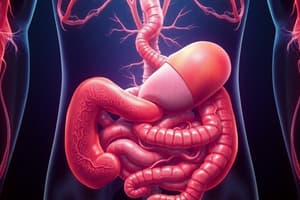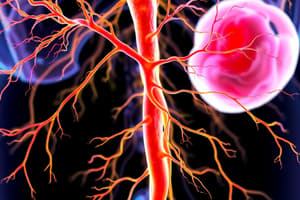Podcast
Questions and Answers
What type of fibers primarily provide the parasympathetic innervation to the thoracic viscera?
What type of fibers primarily provide the parasympathetic innervation to the thoracic viscera?
- Sensory fibers from T1-T5
- Fibers from the pelvic splanchnic nerves
- Postganglionic sympathetic fibers
- Preganglionic parasympathetic fibers (correct)
Where is the deep cardiac plexus primarily located?
Where is the deep cardiac plexus primarily located?
- Anterior to the bifurcation of the trachea (correct)
- In the walls of the coronary arteries
- At the level of T1-T5 vertebrae
- Under the concavity of the arch of the aorta
Which spinal cord segments provide sympathetic nerve input to the cardiac plexus?
Which spinal cord segments provide sympathetic nerve input to the cardiac plexus?
- T1-T5 (correct)
- L1-L3
- C1-C8
- T6-T12
Which of the following effects does sympathetic stimulation have on the heart?
Which of the following effects does sympathetic stimulation have on the heart?
Which spinal cord levels are associated with pain fibers from the appendix?
Which spinal cord levels are associated with pain fibers from the appendix?
What is the source of sympathetic sensory fibers related to the heart?
What is the source of sympathetic sensory fibers related to the heart?
What is the primary control mechanism for peristalsis in the gastrointestinal tract?
What is the primary control mechanism for peristalsis in the gastrointestinal tract?
What is the main component of the autonomic innervation to the heart?
What is the main component of the autonomic innervation to the heart?
What type of nerve fibers are involved in the functional response of increasing coronary artery dilation?
What type of nerve fibers are involved in the functional response of increasing coronary artery dilation?
What is the primary source of sympathetic contributions to the cardiac plexus?
What is the primary source of sympathetic contributions to the cardiac plexus?
What effect does transection of the vagal trunks have on the stomach?
What effect does transection of the vagal trunks have on the stomach?
What is the primary role of the vagus nerve in the thoracic viscera?
What is the primary role of the vagus nerve in the thoracic viscera?
Which spinal cord segments give rise to the thoracic splanchnic nerves?
Which spinal cord segments give rise to the thoracic splanchnic nerves?
Where is referred pain from the appendix most commonly felt?
Where is referred pain from the appendix most commonly felt?
Which type of fibers stimulate acid secretion in the stomach's parietal cells?
Which type of fibers stimulate acid secretion in the stomach's parietal cells?
Where do parasympathetic fibers for abdominal viscera primarily synapse?
Where do parasympathetic fibers for abdominal viscera primarily synapse?
Which of the following structures receives sympathetic fibers from the greater splanchnic nerves?
Which of the following structures receives sympathetic fibers from the greater splanchnic nerves?
Which part of the autonomic nervous system is primarily responsible for relaxation and recovery functions in the body, particularly in entailing the pelvic viscera?
Which part of the autonomic nervous system is primarily responsible for relaxation and recovery functions in the body, particularly in entailing the pelvic viscera?
What characterizes the organization of the aortic plexus?
What characterizes the organization of the aortic plexus?
Which of the following fibers primarily synapse within chromaffin cells of the suprarenal gland?
Which of the following fibers primarily synapse within chromaffin cells of the suprarenal gland?
What role do sensory fibers play in the autonomic innervation of abdominal viscera?
What role do sensory fibers play in the autonomic innervation of abdominal viscera?
What is the primary pathway for parasympathetic fibers from the anterior vagal trunk?
What is the primary pathway for parasympathetic fibers from the anterior vagal trunk?
Which nerves provide sympathetic preganglionic fibers to the aorticorenal plexus?
Which nerves provide sympathetic preganglionic fibers to the aorticorenal plexus?
What characterizes the fibers from the posterior vagal trunk?
What characterizes the fibers from the posterior vagal trunk?
Which plexus is responsible for the parasympathetic innervation of the large intestine up to the left colic flexure?
Which plexus is responsible for the parasympathetic innervation of the large intestine up to the left colic flexure?
Where do most preganglionic fibers in the lesser and least splanchnic nerves synapse?
Where do most preganglionic fibers in the lesser and least splanchnic nerves synapse?
Which of these represents the distal extent of vagal innervation?
Which of these represents the distal extent of vagal innervation?
What is the function of the lower two lumbar splanchnic nerves?
What is the function of the lower two lumbar splanchnic nerves?
Which type of fibers does the intermesenteric plexus receive?
Which type of fibers does the intermesenteric plexus receive?
Which sympathetic nerves contribute to the celiac plexus?
Which sympathetic nerves contribute to the celiac plexus?
Which structures do the pelvic splanchnic nerves (S2-4) provide parasympathetic contributions to?
Which structures do the pelvic splanchnic nerves (S2-4) provide parasympathetic contributions to?
Which of the following statements is true regarding the distribution of preganglionic parasympathetic fibers?
Which of the following statements is true regarding the distribution of preganglionic parasympathetic fibers?
Where do sensory fibers mediating pain from the heart synapse in the spinal cord?
Where do sensory fibers mediating pain from the heart synapse in the spinal cord?
Which plexus utilizes vagus nerves as its primary source of parasympathetic supply?
Which plexus utilizes vagus nerves as its primary source of parasympathetic supply?
Which splanchnic nerves contribute to the inferior mesenteric plexus?
Which splanchnic nerves contribute to the inferior mesenteric plexus?
What is a characteristic of referred pain from visceral organs?
What is a characteristic of referred pain from visceral organs?
Which of the following plexuses is primarily associated with the upper lumbar splanchnic nerves?
Which of the following plexuses is primarily associated with the upper lumbar splanchnic nerves?
Flashcards are hidden until you start studying
Study Notes
Thoracic and Abdominal Viscera Innervation
- Thoracic and abdominal viscera receive autonomic innervation from plexuses, which are networks of nerve fibers from various nerves.
- Parasympathetic input originates from the vagus nerves and is preganglionic.
- Sympathetic input comes from postganglionic neurons in sympathetic trunk ganglia, including cervical and thoracic levels.
Heart Innervation
- The heart is innervated by the cardiac plexus, with superficial and deep components.
- Parasympathetic input comes from the vagus nerves, synapsing in ganglia within the atria and coronary arteries.
- Sympathetic input comes from thoracic and cervical ganglia, influencing heart rate, strength of contraction, and coronary artery dilation.
Thoracic Plexus
- The thoracic plexus includes the cardiac, pulmonary, and esophageal plexuses.
- The sympathetic and parasympathetic contributions to these plexuses are from specific levels of cervical and thoracic ganglia.
Abdominal Viscera Innervation
- Abdominal viscera are innervated via autonomic fibers located primarily on the aorta and its branches.
- Sympathetic input comes from preganglionic thoracic splanchnic nerves (greater, lesser, least) and lumbar splanchnic nerves, synapsing in ganglia within the plexuses.
- Parasympathetic input comes from preganglionic vagal nerves and pelvic splanchnic nerves (S2-S4), often synapsing within the walls of the viscera.
- Sensory fibers travel with both sympathetic and parasympathetic components.
Aortic Plexus
- The aortic plexus, the largest prevertebral plexus, is located at the T12-L3 levels and is associated with various arterial branches.
- The celiac ganglion, the largest named ganglion, receives sympathetic fibers from the greater splanchnic nerves (T5-T9).
- Some greater splanchnic nerve fibers continue without synapsing in the celiac ganglion, reaching other ganglia or the adrenal gland.
- Parasympathetic fibers from the vagus nerves generally bypass the celiac plexus, directly innervating the stomach, duodenum, etc.
- The aorticorenal plexus, located adjacent to the renal arteries, receives sympathetic input from the lesser and least splanchnic nerves (T10-T12).
- The intermesenteric plexus, located between the superior and inferior mesenteric plexuses, receives sympathetic input from the upper two lumbar splanchnic nerves (L1-L2).
- The inferior mesenteric plexus receives parasympathetic input from the pelvic splanchnic nerves (S2-S4) via the superior hypogastric plexus and hypogastric nerves.
Abdominal Plexus
- The abdominal plexuses include the celiac, aorticorenal, superior mesenteric, intermesenteric, and inferior mesenteric plexuses.
- Each plexus receives specific sympathetic and parasympathetic input from different spinal cord levels.
Clinical Anatomy
- Visceral pain travels back to the spinal cord using the same pathways used for sympathetic innervation.
- Referred pain occurs when visceral pain is perceived as originating from the somatic area supplied by the same spinal cord segments.
- Examples include heart pain referred to the chest and upper limb, gall bladder pain referred to the upper abdomen, and appendix pain referred to the umbilical region.
- Parasympathetic fibers control gastrointestinal peristalsis and acid secretion in the stomach.
- Transection of the vagal trunk can be done to reduce excessive acid formation associated with peptic ulcers.
Summary
- Nerves innervating thoracic and abdominal viscera travel along the vessels supplying those organs.
- Sympathetic preganglionic fibers typically synapse in ganglia associated with the plexuses, while parasympathetic preganglionic fibers generally synapse directly in the walls of the target organs.
Abdominal Innervation Diagram
- The diagram includes the following structures: anterior vagal trunk, posterior vagal trunk, celiac ganglion, greater splanchnic nerves, lesser splanchnic nerves, least splanchnic nerves, superior mesenteric ganglion, aorticorenal ganglion, kidneys, renal plexus, upper lumbar splanchnic nerves, sympathetic ganglion and trunk, lower lumbar splanchnic nerves, intermesenteric plexus, inferior mesenteric ganglion, superior hypogastric plexus, and hypogastric nerves.
Studying That Suits You
Use AI to generate personalized quizzes and flashcards to suit your learning preferences.




